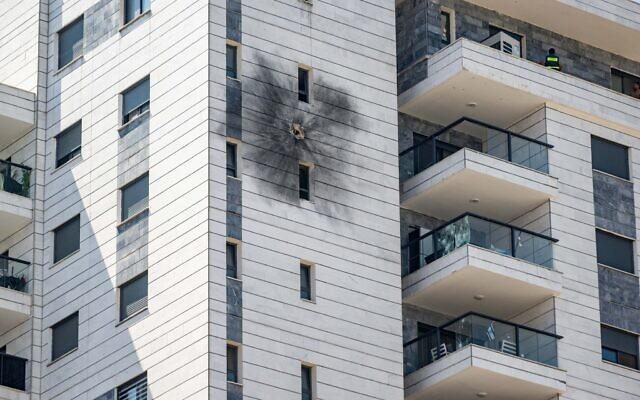
Hezbollah drone hits Nahariya high-rise, as over 20 rockets fired at north
Lebanon’s Hezbollah on Monday launched explosive-laden drones at northern Israel, one of which impacted a high-rise residential building in the coastal city of Nahariya, causing damage, authorities said.
The Israel Defense Forces said two drones were launched in the attack, which was later claimed by the terror group.
There were no injuries in the attack, though the drone that hit the building caused damage to two apartments.
In a statement, the terror group took responsibility for the drones but claimed to have targeted a military base, the IDF’s Shraga Camp, some three kilometers (1.8 miles) south of Nahariya.
Hezbollah said the attack was a response to recent IDF strikes in southern Lebanon.
IDF Chief of Staff Lt. Gen. Herzi Halevi called the attack “a serious incident.”
Wrapping up an assessment on the northern front with the military’s top brass, Halevi said the “IDF operates strongly in the north, and is at a high level of readiness with prepared operational plans, ready for any mission that will be required.”
Dr. Maron Haj, a thoracic surgeon at Galilee Medical Center, said he was at work in the hospital when he heard his building was hit.
“Everything in our apartment was ruined,” he said. “We can’t live there. We have to figure out what to do next.”
Describing the attack, 9-year-old Aviel Avshalom, who was in school at the time, said it was “very scary.”
His mother, Alina Avshalom, said she hurried to pick up Aviel and his sister Miel from school — despite a call by Nahariya’s mayor to parents not to pick up their children.
“I don’t have a car and I had to think twice — but I didn’t want to leave the kids there,” she said.
In another attack on the Western Galilee on Monday, three explosive-laden drones launched from Lebanon struck near the border community of Shlomi, lightly injuring two soldiers, the IDF said.
Hezbollah took responsibility for the attack, saying it targeted a military base in the area.
The IDF said the soldiers were taken to a hospital in good condition.
In addition to the drones, Hezbollah also fired more than 20 rockets from Lebanon at northern Israel on Monday, according to the IDF.
The rockets targeted the Western Galilee, the Kiryat Shmona area, and the Galilee Panhandle.
There were no reports of injuries.
The terror group also claimed to have launched a surface-to-air missile at an Israeli fighter jet over southern Lebanon on Monday, forcing it to retreat.
Meanwhile, on Monday, the IDF said fighter jets struck several buildings and observation posts belonging to Hezbollah in southern Lebanon’s Kafr Kila.
Another drone strike targeted a Hezbollah operative in Tallouseh, the military said.
Separately, Israeli tanks shelled a Hezbollah observation post in Kafr Shouba, the IDF added.
Overnight, Israeli fighter jets struck several sites and a rocket launcher belonging to Hezbollah in southern Lebanon’s Kafr Kila, Taybeh, Hanine, and Yarine, the IDF said earlier Monday.
A separate strike on Sunday night in Khirbet Selm targeted a building used by Hezbollah, the military added.
Amid the ongoing exchanges of fire between Israel and Hezbollah, US CENTCOM chief Gen. Michael Kurilla, who was again visiting Israel, met with IDF Chief of Staff Lt. Gen. Herzi Halevi and other generals on Sunday, the Israeli military said.
The IDF said the visit “focuses on current threats, with an emphasis on threats from Lebanon and Iran in the northern arena.”
After an assessment with Halevi, Kurilla met with Northern Command chief Maj. Gen. Ori Gordin at the command’s underground war room, where the military said he was “presented with the IDF’s operational plans for Lebanon.”
“The IDF will continue to deepen its relationship with the US Armed Forces, due to our commitment to strengthening regional stability and the coordination between the militaries,” the IDF added.
On Sunday, Kurilla met with Defense Minister Yoav Gallant.
Gallant on X said that they had discussed “the operational and strategic situation in the region” and “reflected on ways to further strengthen interoperability to achieve our common objectives.”
Since October 8, Hezbollah-led forces have attacked Israeli communities and military posts along the border on a near-daily basis, with the group saying it is doing so to support Gaza amid the war there.
So far, the skirmishes have resulted in 26 civilian deaths on the Israeli side, as well as the deaths of 20 IDF soldiers and reservists. There have also been several attacks from Syria, without any injuries.
Hezbollah has named 433 members who have been killed by Israel during the ongoing skirmishes, mostly in Lebanon but some also in Syria. Another 78 operatives from other terror groups, a Lebanese soldier, and dozens of civilians have also been killed.
Source » timesofisrael.com





